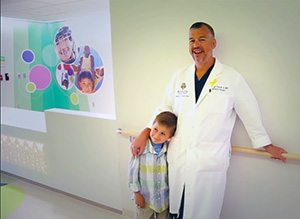Getting Set for Phase II
The doors opened on an all-new Golisano Children’s Hospital in July, but the story of the hospital’s evolution isn’t over. In fact, an exciting new chapter is just about to begin.
So ambitious were the plans for Golisano Children’s Hospital that the project was conceived in two phases, to be completed over several years. Phase I wrapped up in July with completion of the eight-floor hospital tower, which includes the Walmart and Sam’s Club Pediatric Lobby, Gosnell Family Neonatal Intensive Care Unit, two inpatient floors, a dedicated pediatric imaging suite, Ronald McDonald Family Room, family lounges, and the two-story Simonetti play deck, to name just a few of its features.
Next up: Phase II, which includes construction of new pediatric operating rooms, surgical support space and an expanded Pediatric Intensive Care Unit (PICU). Each year 85,000 children from the 17-county Finger Lakes region and beyond come to Golisano Children’s Hospital – often seeking surgical services or complex care that can only be found at Golisano. The project will bring exciting and greatly needed new surgical and patient-care capabilities to the new children’s hospital.
 “Current pediatric operating rooms and pre- and post-operative facilities were not designed to support state-of-the-art pediatric care,” said Walter Pegoli, M.D., Chief of Pediatric Surgery at Golisano Children’s Hospital. “In a new, larger and updated facility, we will be able to perform minimally invasive surgical procedures, hybrid procedures that combine minimally invasive with traditional techniques, and new treatment paths for pediatric cardiac surgery.”
“Current pediatric operating rooms and pre- and post-operative facilities were not designed to support state-of-the-art pediatric care,” said Walter Pegoli, M.D., Chief of Pediatric Surgery at Golisano Children’s Hospital. “In a new, larger and updated facility, we will be able to perform minimally invasive surgical procedures, hybrid procedures that combine minimally invasive with traditional techniques, and new treatment paths for pediatric cardiac surgery.”
The current pediatric catheterization laboratory is co-located in the adult cardiac facility at Strong Memorial Hospital and does not have dedicated pediatric anesthesia on a consistent basis, which is important for pediatric catheterization and EP cases. Similarly, the current gastroenterology operating room does not have co-located support space for this growing service.
Expansion of pediatric intensive care capacity is urgently needed as well. Golisano Children’s Hospital’s PICU, currently licensed to operate 12 beds, is the only of its kind in the Finger Lakes region, and for the past three years has averaged 95 percent capacity. The addition of intensive care beds supports the hospital’s ability to provide specialized surgery and emergency critical care, Pegoli explained:
“As Golisano Children’s Hospital has recruited more pediatric surgical specialists in congenital heart surgery, spine surgery, craniofacial, neurology, ENT, electrophysiology, general surgery, and gastroenterology, we have increased our critical care case volumes. We are the only center in upstate New York for some of these specialties, including complex pediatric cardiovascular surgery, neurology and electrophysiology. Having additional beds reduces the risk that patients will need to be transported long distances to other centers because we lack capacity.”
When the new Golisano Children’s Hospital opened in July, floors 4 and 6 in the hospital tower were left as “shell floors” – vacant, but ready for their build-out in Phase II. Here are details on what each new floor will contain when Phase II is complete:
Fourth Floor:
-
Six new operating rooms, including a dedicated pediatric cardiac OR
-
24 private pre-operative and post-operative recovery rooms
-
A gastroenterology surgical procedure suite
-
Dedicated pediatric catheterization/electrophysiology laboratory
-
Pediatric-friendly waiting space for families
Sixth Floor - Pediatric Intensive Care Unit (PICU):
-
Relocation of the current 12 ICU and 10 general care pediatric beds to new rooms in the tower
-
Addition of six pediatric ICU beds to accommodate the rising demand for care and further enhance efficiencies of having all beds co-located in the new children’s tower
UR Medicine has filed a Certificate of Need application with the state Department of Health for permission to proceed with the $45M project. Upon approval from the Department of Health, construction will begin in fall 2015 and the new facilities will open in July 2017.